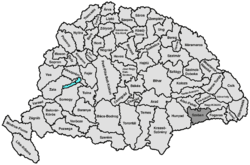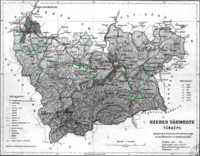Szeben County
| Szeben County Comitatus Cibinensis (Latin) Szeben vármegye (Hungarian) Komitat Hermannstadt (German) Comitatul Sibiu (Romanian) | |||||
| County of the Kingdom of Hungary | |||||
| |||||
|
Coat of arms | |||||
 | |||||
| Capital | Nagyszeben 45°48′N 24°9′E / 45.800°N 24.150°ECoordinates: 45°48′N 24°9′E / 45.800°N 24.150°E | ||||
| History | |||||
| • | Established | 1876 | |||
| • | Treaty of Trianon | 4 June 1920 | |||
| Area | |||||
| • | 1910 | 3,619 km2 (1,397 sq mi) | |||
| Population | |||||
| • | 1910 | 176,900 | |||
| Density | 48.9 /km2 (126.6 /sq mi) | ||||
| Today part of | Romania | ||||
| Sibiu is the current name of the capital. | |||||
Szeben was an administrative county (comitatus) of the Kingdom of Hungary. Its territory is now in central Romania (southern Transylvania). The capital of the county was Nagyszeben (present-day Sibiu).
Geography
Szeben county shared borders with Romania and the Hungarian counties Hunyad, Alsó-Fehér, Nagy-Küküllő and Fogaras. The river Olt flowed through the county. Its area was 3619 km² around 1910.
History
Szeben county was formed in 1876, when the administrative structure of Transylvania was changed. In 1920, by the Treaty of Trianon the county became part of Romania. Its territory lies in the present Romanian counties Sibiu and Alba (the area around Sebeş).
Demographics
In 1900, the county had a population of 229,361 people and was composed of the following linguistic communities:[1]
Total:
- Romanian: 108,413 (65.2%)
- German: 47,678 (28.7%)
- Hungarian: 8,084 (4.9%)
- Slovak: 106 (0.0%)
- Croatian: 95 (0.0%)
- Ruthenian: 50 (0.0%)
- Serbian: 36 (0.0%)
- Other or unknown: 1,726 (1.0%)
According to the census of 1900, the county was composed of the following religious communities:[2]
Total:
- Eastern Orthodox: 95,380 (57.4%)
- Lutheran: 43,439 (26.1%)
- Greek Catholic: 14,050 (8.4%)
- Roman Catholic: 8,747 (5.3%)
- Calvinist: 3,147 (1.9%)
- Jewish: 1,107 (0.7%)
- Unitarian: 301 (0.2%)
- Other or unknown: 17 (0.0%)

In 1910, county had a population of 176,921 people and was composed of the following linguistic communities:[3]
Total:
- Romanian: 113,672 (64.3%)
- German: 49,757 (28.1%)
- Hungarian: 10,159 (5.7%)
- Ruthenian: 205 (0.1%)
- Slovak: 154 (0.0%)
- Serbian: 95 (0.0%)
- Croatian: 84 (0.0%)
- Other or unknown: 2,795 (1.6%)
According to the census of 1910, the county was composed of the following religious communities:[4]
Total:
- Eastern Orthodox: 99,952 (56.5%)
- Lutheran: 45,912 (26.0%)
- Greek Catholic: 16,064 (9.1%)
- Roman Catholic: 9,503 (5.4%)
- Calvinist: 3,528 (2.0%)
- Jewish: 1,565 (0.9%)
- Unitarianist: 379 (0.2%)
- Other or unknown: 18 (0.0%)
Subdivisions
In the early 20th century, the subdivisions of Szeben county were:
| Districts (járás) | |
|---|---|
| District | Capital |
| Nagydisznód | Nagydisznód, RO Cisnădie |
| Nagyszeben | Nagyszeben, RO Sibiu |
| Szászsebes | Szászsebes, RO Sebeş |
| Szelistye | Szelistye, RO Săliște |
| Szerdahely | Szerdahely, RO Miercurea Sibiului |
| Újegyház | Újegyház, RO Nocrich |
| Urban districts (rendezett tanácsú város) | |
| Nagyszeben, RO Sibiu | |
| Szászsebes, RO Sebeş | |
References
- ↑ "KlimoTheca :: Könyvtár". Kt.lib.pte.hu. Retrieved 2012-12-06.
- ↑ "KlimoTheca :: Könyvtár". Kt.lib.pte.hu. Retrieved 2012-12-07.
- ↑ "KlimoTheca :: Könyvtár". Kt.lib.pte.hu. Retrieved 2012-12-07.
- ↑ "KlimoTheca :: Könyvtár". Kt.lib.pte.hu. Retrieved 2012-06-20.

